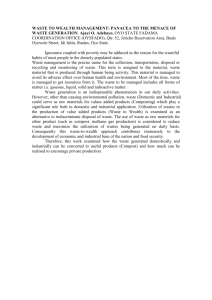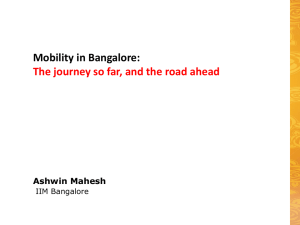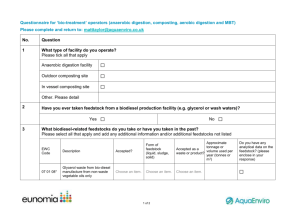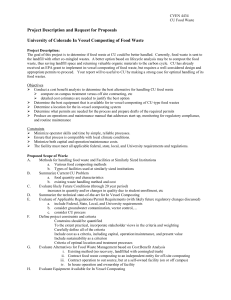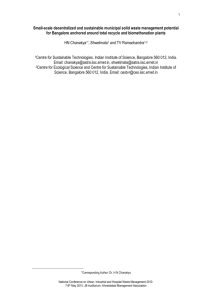Waste Disposal In Bangalore 2003
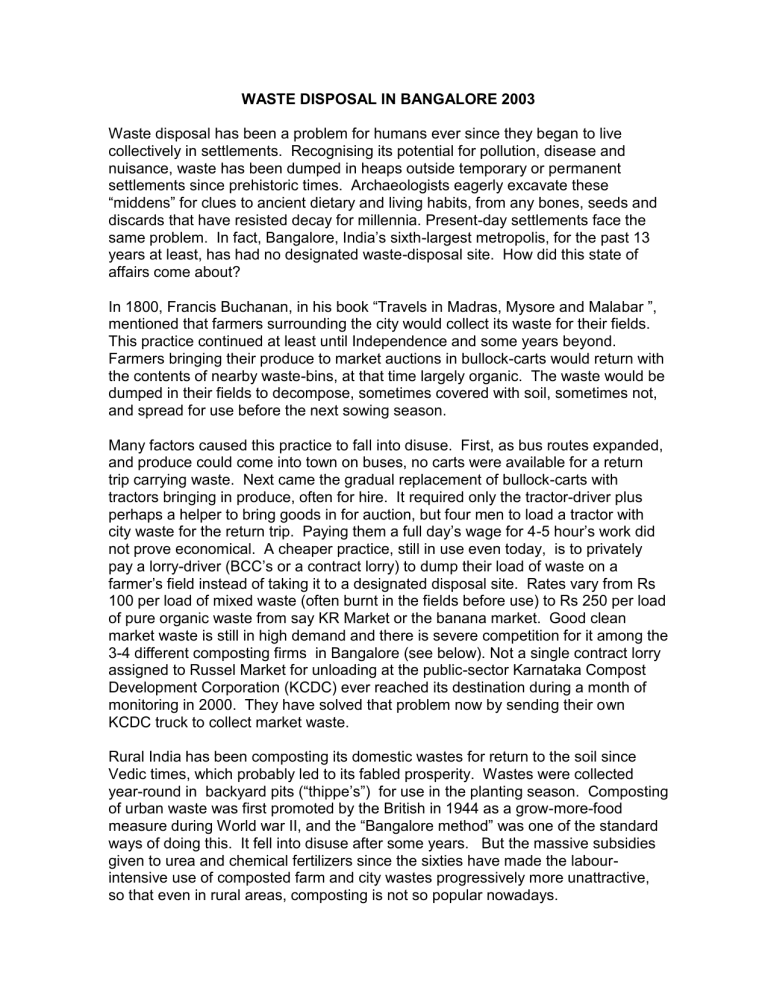
WASTE DISPOSAL IN BANGALORE 2003
Waste disposal has been a problem for humans ever since they began to live collectively in settlements. Recognising its potential for pollution, disease and nuisance, waste has been dumped in heaps outside temporary or permanent settlements since prehistoric times. Archaeologists eagerly excavate these
“middens” for clues to ancient dietary and living habits, from any bones, seeds and discards that have resisted decay for millennia. Present-day settlements face the same p roblem. In fact, Bangalore, India’s sixth-largest metropolis, for the past 13 years at least, has had no designated waste-disposal site. How did this state of affairs come about?
In 1800, Francis Buchanan, in his book “Travels in Madras, Mysore and Malabar ”, mentioned that farmers surrounding the city would collect its waste for their fields.
This practice continued at least until Independence and some years beyond.
Farmers bringing their produce to market auctions in bullock-carts would return with the contents of nearby waste-bins, at that time largely organic. The waste would be dumped in their fields to decompose, sometimes covered with soil, sometimes not, and spread for use before the next sowing season.
Many factors caused this practice to fall into disuse. First, as bus routes expanded, and produce could come into town on buses, no carts were available for a return trip carrying waste. Next came the gradual replacement of bullock-carts with tractors bringing in produce, often for hire. It required only the tractor-driver plus perhaps a helper to bring goods in for auction, but four men to load a tractor with city waste for the return trip. Paying them a full day’s wage for 4-5 hour’s work did not prove economical. A cheaper practice, still in use even today, is to privately pay a lorrydriver (BCC’s or a contract lorry) to dump their load of waste on a farmer’s field instead of taking it to a designated disposal site. Rates vary from Rs
100 per load of mixed waste (often burnt in the fields before use) to Rs 250 per load of pure organic waste from say KR Market or the banana market. Good clean market waste is still in high demand and there is severe competition for it among the
3-4 different composting firms in Bangalore (see below). Not a single contract lorry assigned to Russel Market for unloading at the public-sector Karnataka Compost
Development Corporation (KCDC) ever reached its destination during a month of monitoring in 2000. They have solved that problem now by sending their own
KCDC truck to collect market waste.
Rural India has been composting its domestic wastes for return to the soil since
Vedic times, which probably led to its fabled prosperity. Wastes were collected yearround in backyard pits (“thippe’s”) for use in the planting season. Composting of urban waste was first promoted by the British in 1944 as a grow-more-food measure during World war II, and the “Bangalore method” was one of the standard ways of doing this. It fell into disuse after some years. But the massive subsidies given to urea and chemical fertilizers since the sixties have made the labourintensive use of composted farm and city wastes progressively more unattractive, so that even in rural areas, composting is not so popular nowadays.
2
What finally killed the return of city wastes to the land, countrywide, was the arrival of the Plastic Yug in the sixties, with galloping amounts of plastic (especially carrybags) ending up in waste from the eighties onwards. Thin plastic littered in fields prevents rainwater from entering the ground, and prevents seedlings from germinating through them. Cattle eating food-filled plastic bags choke on these and become ill and slowly die. Initially, it was worthwhile for rag-pickers to collect carrybags for recycling. Increasing volumes have brought down prices of this waste to below-subsistence rates for collectors. Additionally, interrupted or single-phase power supply and low voltage have forced many recyclers to close down.
Technology changes in the form of new piping for optic-fibre cables have reduced demand for the underground pipes that were made from recycled plastic, further slashing demand for waste plastic. Hence there are few rural takers for plastic-filled city waste.
The response to these developments took two forms. First, Bangalore looked for discontinued quarries in which to throw its unwanted mixed waste, not merely organics mixed with recyclables but both of these also mixed with inerts like road dust, drain silt and debris, which made all three types of wastes unusable. Quarries and low-lying areas are the worst possible places to deposit untreated waste, which rots in the absence of air to produce foulsmelling black “leachate” that percolates through garbage and pollutes wells and groundwater over long distances. The process is almost irreversible, and cleanup can take 15-20 years, if at all. Over time, quarries like the one at what is now Jayanagar T Block got filled in and built up. The quarry behind Binny Mill was filled up around 1990.
Thereafter, BCC (Bangalore City Corporation) abdicated all responsibility for what happened to the garbage it collected and where it went. Lorries were encouraged to just drive out of town and find their own places to dump waste, anywhere beyond the city limits. This particularly suited the transport contractors who handle 55% of
Bangalore’s waste, about 90% of them connected to previous or current
Corporators. Naturally they took the cheapest option, fuelwise and timewise, and waste began to be unloaded on the road shoulders of all the radial roads leading out of town. When these filled up, even after deliberate burning failed to reduce the heap volumes because of inerts, lorries began to move into the interior, looking for
“no-man’s land” spaces such as revenue lands or those sold by farmers to longterm speculators who did not care what happened to their lands. Given this lack of
BCC supervision, even when six new quarry-sites were Notified by the State govt in
October 1994 for waste disposal, not one was put to use, because neither BCC nor private transporters wished to unload at a designated spot where their trips could be counted and their transport-billing verified and tallied. Even though these six quarries have now been earmarked for dumping of debris only (which is ecologically acceptable), BCC supervision and management is non-existent. As a result, debris unloaded around the rim of the quarry is never bull-dozed inside for filling, mounting piles of debris make further access impossible, and the debris trucks continue to proceed further and unload along road shoulders, thus ruining the quality of newlyasphalted roads and creating traffic congestion.
3
Such random dumping all around the city causes not just the environmental pollution of land, water, and air from smoking garbage dumps, but also has health, economic and social consequences. Fly, mosquito and rodent populations shoot up in the vicinity. Such dumps also support huge numbers of stray dogs that breed without a human touch and become feral (reverting to wild ways). They form hunting packs at night that attack village livestock , regularly attacking poultry farms and killing sheep, goats and even calves. Labourers are harassed by dog-packs on their way home at twilight. School-going children regularly fall off scooters that collide with fighting dogs dashing across the roads where garbage is dumped.
This random-dumping policy has now backfired. The volumes of waste dumped all over are so large, and so widespread, and so close to the new developments coming up daily as a reaction to BDA acquisition moves, that villagers are now up in arms about such dumping and stone these transport vehicles or slash their tyres to protect their habitat. This is also costing the transport contractors dearly. Their trucks have to travel further and further to unspecified lonely locations and for longer times, so owners are losing control of the fuel demands of their drivers and the time required for their job. As a result, there has been a big change recently, with both BCC drivers and transport contractors going on strike and demanding fixed disposal sites to which they can go for unloading.
Meanwhile, the pollution of her rural road by uncontrolled dumping led Almitra Patel, a retired e ngineer, to join Capt Velu’s Clean India Campaign after the Surat plague.
Driving to over 60 municipalities in 1994 and 1995, they found waste dumped on highways outside almost all Indian cities. That led her to file a PIL (public interest litigation) No 888/96 in the Supreme Court, seeking hygienic and ecofriendly waste disposal in all 300 Class 1 Cities of over 1 lakh population. The Court appointed an
8-member Committee to suggest remedies, which were widely approved by almost
400 municipal officials. Their Report and Supreme Court urging led to India’s first
Municipal Solid Waste (Management & Handling) Rules in September 2000, which apply to all urban local bodies, even those of population 20,000 and over, as well as agencies like Defence, Railways, Industrial Estates etc. Briefly, these MSW Rules advocate that “wet” food wastes and “dry” recyclable wastes should not be mixed at the household or commercial level, so that the wet waste can be collected door-todoor in an ideally bin-less city and sent for composting, while the dry waste can be left to the informal sector’s ragpickers and kabadiwalas for recycling as usual. The
MSW Rules make it mandatory for biodegradable urban wastes to be composted, vermicomposted etc by December 2003, and bans the burning of garbage and even dry leaves.
Bangalore is one of 12 Indian cities where “Fertiplants” for composting waste were put up in 1975. These mechanized pre-sorting compost plants were a copy of plants `designed for developed-country wastes, where organics are only 16-24%, unlike India’s 50-80% food wastes. As a result of such inappropriate design, all the plants failed and gave composting a severe setback countrywide. KCDC was the only plant that did not close down, by composting the mixed waste as-received and removing the unwanted items later, using simple sieves. It was not until Excel
Industries in Mumbai developed effective biocultures for rapid composting of mixed
4 waste in about 60 days during the 90s that composting again became a feasible option for waste management. Dr Vaman Acharya brought this technology to
Bangalore in 1996 as a social service business. Before that, Ganesha started a large-scale vermicomposting operation for market wastes in 1994. Bangalore thus had three compost plants even before the MSW Rules. But these can handle a total of only onefourth of Bangalore’s 2000 tons a day of waste. The rest still goes for random dumping and burning.
This is not for want of space now, but only because of poor management and total lack of control of waste disposal. In 2001, the State finally gave BCC 2-3 sites for waste processing. A 25-acre isolated site at Kanahalli off Magadi Road was given to KCDC to develop. Instead of managing the waste hygienically from day one, trucks rushed to dump unmanageable heaps of burning and rotting waste on the virgin site, polluting the neighbourhood tank. As a result, the villagers blocked the road, burnt the JCB, and this precious site lies unused since over 2 years. Not learning from this experience, another 36-acre site at Kyalsanahalli, surrounded by a fair amount of urban development, has been similarly lost by haphazard and polluting dumping without any dialogue with the locals. A third potential isolated site of about 100 acres north of the city is already being trashed by illegal dumping and burning of heaps. If this continues, Bangalore will continue to be India’s largest city with nowhere to put its wastes.
Dialogue with villagers, at the earliest possible stage, is of the utmost importance for a long-term win-win solution. It will also be necessary for BCC and the seven growing CMCs (City Municipal Councils) surrounding it, to recognize the 73 rd
Amendment rights of the villages where they intend to process and dispose of their wastes, and to also adopt a polluter-pays policy of compensating the villagers for the inconvenience of hosting city waste, for example by providing infrastructure or services badly needed by the host village, and by giving them a stake in the successful operation of the compost plant through annual distribution of say a ton of compost per village family (landed or landless) at very nominal rates. Declaration of a No-New-Development zone around a compost plant is not only mandatory, but necessary for the long-term survival of any site. Villagers can be given all encouragement for horticulture or silviculture as a shelter-belt on private lands around the selected site.
Most importantly, effective waste management through composting also requires a lot of water : 200-300 litres per ton of waste, or an average of 5 lakh litres of water per day in non-monsoon months. This should as far as possible be from surface waters or treated waste-water (free of toxics or heavy metals), so that precious ground-water is not depleted in a water-scarce city like Bangalore. This will require effective coordination between different ministries, if Bangalore is ever to have surroundings “as clean as Singapore”.
July 2003
Mrs Almitra H Patel, Member, Supreme Court Committee for Solid Waste Mgt
50 Kothnur, Bagalur Rd Bangalore 560077. almitrapatel@rediffmail.com


